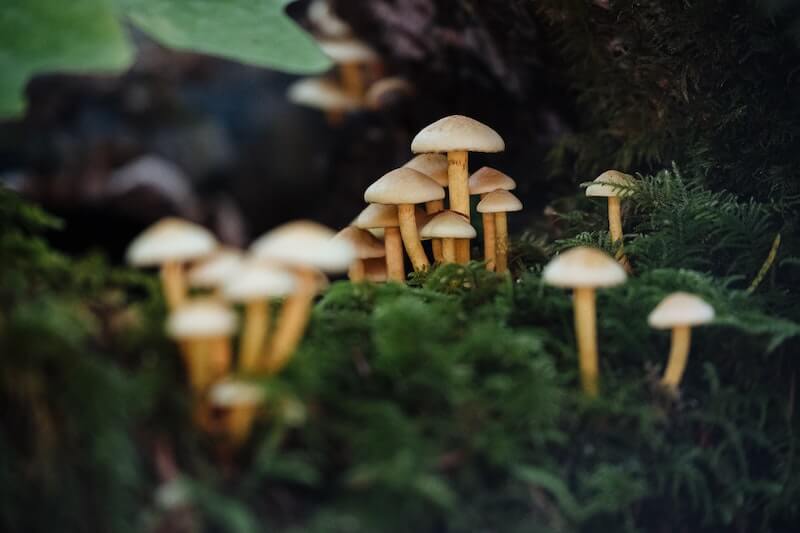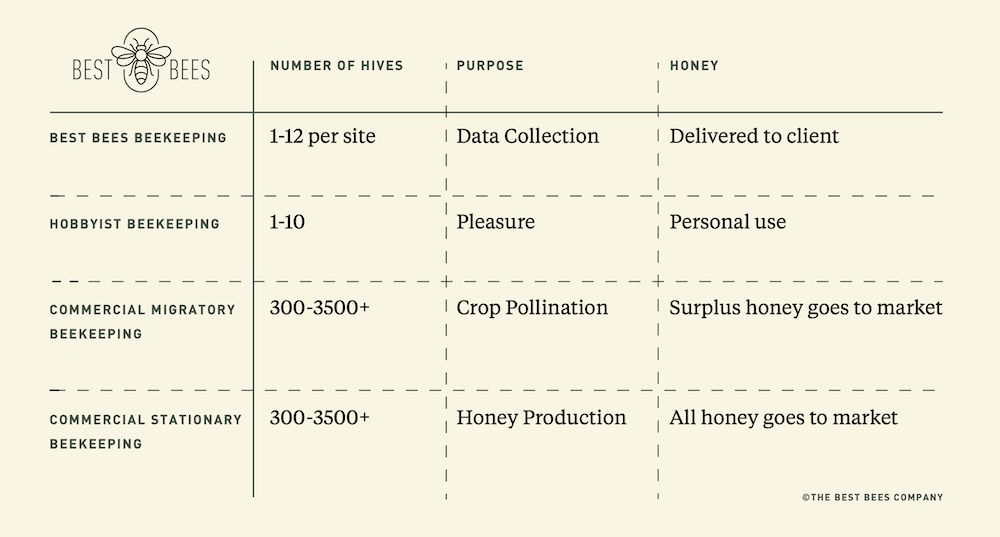Contents:
- What is Fungi?
- The Relationship Between Fungi and Honey Bees
- Why Do Honey Bees Need Help?
- Treatment Methods for Varroa Mites
- How Fungus Metarhizium Can Help Honey Bees
- How Mycelium Extracts Can Help Honey Bees
- How are The Best Bees Company Beekeepers Helping Honey Bees?
What is Fungi?
What do you call someone that likes to party? A pretty Fungi!
What’s that musical group that also likes to make bread? The Yeastie Boys!
What do the Fungi and The Yeastie Boys have in common? They can help our planet heal.
Fungi are somewhat of a mystery in the inner workings of Mother Nature. Most of us know fungi as tasty mushrooms that we put in our stir fry (or not tasty depending on who you talk to), mold that grows on two-week old strawberries, or yeast that’s used to make some of our favorite brewskies. However, the world of fungi is incredibly vast. It is so vast, that scientists have identified 144,000 species of fungi, yet estimate there are between 2.2 million and 3.8 million total species. Before launching into a discussion about the wonders of fungi, here is a quick vocab breakdown:
Fungus/Fungi: Any organism that belongs to the Kingdom Fungi (such as yeast, mold, mildew, mushrooms, etc.)
Mycelium: The vegetative branching body of certain fungi found underground.
Mushroom: The fruiting body of mycelium.
The Relationship Between Fungi and Honey Bees
Paul Stamets, a world-renowned mycologist, is one of the few that have dedicated their lives to exploring the mysteries of fungi. Some of his many areas of research include mycofiltration (how mycelium can filter out pathogens), mycoremediation (how mycelium can filter out toxins from the soil), mycopesticides (using mycelium to control insect populations), the medicinal properties of mycelium, evidence for mycelial intelligence, and, yes–how mycelium can help improve honey bee health. When Paul Stamets observed bees vivaciously foraging the oozing droplets of fungi growing in a wood chip bed, he had an “Aha” moment. He had previously worked on a project demonstrating the antiviral properties of mycelial extracts on human cells. Maybe those extracts could have a similar impact on honey bees. Thus, the relationship between mushrooms and honey bees was finally going to be explored.
For more information about Paul Stamets, visit his website: https://paulstamets.com/. He is also the founder and co-owner of Fungi Perfecti, a business selling fungi-based products that benefit the health of humans and other beings alike. Check it out at https://fungi.com/.
Why Do Honey Bees Need Help?
The most destructive parasite that European honey bees face today is the varroa destructor, otherwise known as the varroa mite. Varroa mites originally evolved alongside Asian honey bees, who have learned to successfully live with them. But, in 1987, they jumped to the European honey bee and have since spread to every continent, minus Australia. They reproduce in capped honey bee pupa cells, making them hard for worker bees to detect and remove. Once newly developed bees emerge from their cells, the mites latch onto the backs of adult bees and feed off their hemolymph (blood). As a result, bees’ fat stores decrease, their production of royal jelly for developing larva decreases, and their immune system functions are suppressed.
Eight viruses are known to be vectored by varroa mites, two common ones being deformed wing virus and chronic bee paralysis. There are at least twenty more that scientists suspect are vectored by varroa mites, and there are likely several more viruses that scientists don’t even know about yet. If varroa mite infestations go unchecked, it is likely that a colony will collapse due to Parasitic Mite Syndrome (PMS). PMS is a condition that causes a honey bee colony to deteriorate and eventually dwindle away and die. More information about PMS can be found here.
Below is a graph showing varroa mite and honey bee population growth. This illustrates why varroa mites are so destructive, especially in the fall (represented by the right half of the x-axis).
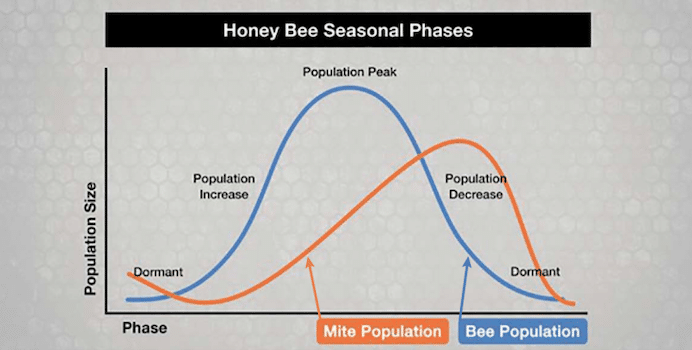
Treatment Methods for Varroa Mites
There is a tier of treatment methods for varroa mites. First, control mite reproduction from the get-go. Second, use mechanical methods to kill mites (hand-killing mites, trapping them, etc.) Third, use soft (organic) chemicals for treatment. Fourth, use hard (synthetic) chemicals. This structure is illustrated in the graph below:

If a beekeeper uses multiple techniques within one tier and/or from different tiers shown in the graph above, this is called Integrated Pest Management. IPM, or using several methods of treatment, is by far the best way to treat varroa mites, as opposed to using only one exclusive method of treatment. The Best Bees Company beekeepers primarily use organic chemical treatments for varroa mites. When possible, they will remove drone brood (ripe varroa mite breeding ground) and freeze it to physically remove mites. However, what if there is a treatment that doesn’t fall within this hierarchy at all? Something that kills varroa mites, isn’t potentially chemically harmful to the bees, and is highly effective? Researchers at Washington State University may have found a solution.
How Fungus Metarhizium Can Help Honey Bees
A team of entomologists and mycologist Paul Stamets worked together to breed a strain of a common fungus found in soils, Metarhizium, to survive beehive temperatures up to 35 degrees Celsius (95 degrees Fahrenheit). During experiments in 48 live colonies in 2017 and 2018, a small petri dish of Metarhizium was placed on top of the frames in each hive. When spores contacted varroa mites, the spores germinated, drilled into the mite, and grew from inside the mite’s body outward. During these experiments, honey bees had high immunity against the fungus, indicating that Metarhizium could be relatively safe to use in beehives. The next step is getting approval from the Environmental Protection Agency for use in agriculture. Steve Sheppard, one of the entomologists on the research team, said that he hopes in ten years, Metarhizium as a biocontrol will be widely used to control varroa mites instead of chemical miticides.
For more information, visit their publicly available published research paper: https://www.nature.com/articles/s41598-021-89811-2
Also, visit this press release of their research: https://news.wsu.edu/press-release/2021/05/27/fungus-fights-mites-harm-honey-bees/
Researchers include entomologists Steve Sheppard, Jennifer Han, Nicholas Naegar, Brandon Hopkins, and mycologist Paul Stamets.
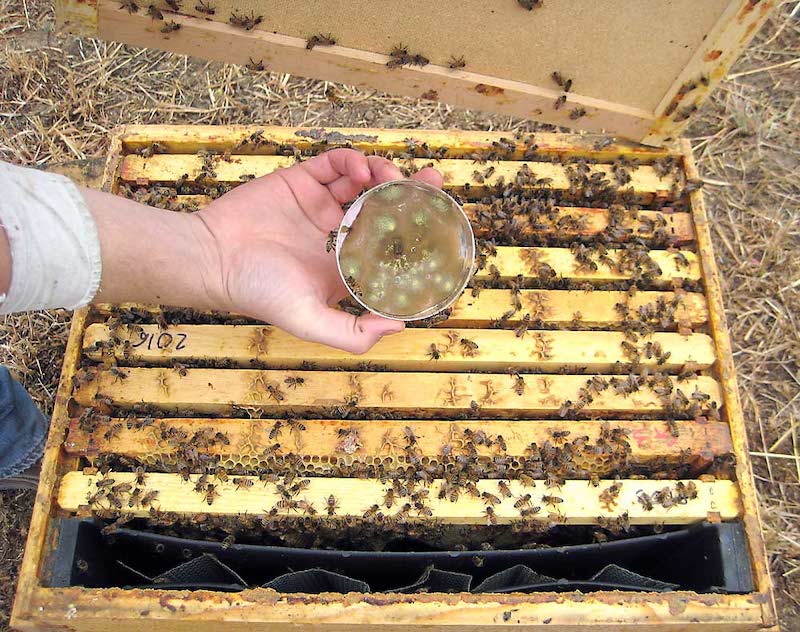
How Mycelium Extracts Can Help Honey Bees
Researchers are also exploring new ways to improve the overall immune health of honey bee colonies. In 2018, the same research team at Washington State University studied how extracts of amadou and Reishi mycelium helped reduce virus loads in varroa mite-infested colonies, specifically Deformed Wing Virus (DWV) and Lake Sinai Virus. Fungi have been long known to produce chemicals that fight against bacteria, other fungi, and viruses. Coupled with this, bees have been observed foraging on mushroom mycelium. This suggests that honey bees have already been foraging from mushrooms to collect antimicrobial medicine to boost their collective immunity. In their field trials, the team found that feeding bees sugar water with the amadou and reishi mycelium extracts reduced DWV 79-fold on average, and Lake Sinai Virus 45,000-fold on average.
Paul Stamets and Dr. Sheppard are currently in the process of developing and patenting the extracts into a product called the BeeMushroomed™ Feeder. It is designed for anybody to place outside for free and easy honey bee access. Dr. Sheppard and his research team are doing more work to refine their research results while the feeder is still in development. Those who are interested in being kept up to date, can sign up for more information at https://fungi.com/pages/bees.
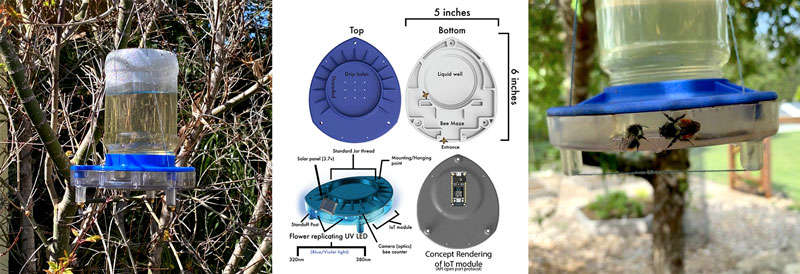
With this exciting research, there are still a lot of questions unanswered. Dr. Renata Borba, a specialist in the benefits that plant resins provide to honey bee health, questions how long the antiviral effect lasts, if the mycelium extracts interfere with bee gut microbial activity, and if there are any long term side effects. A long-term study would be necessary before approving and producing the extracts on a mass scale. To read more about the lingering questions, visit: https://americanbeejournal.com/mycelium-medicine/
While research is still in early development, this is a promising find that could significantly help reduce virus loads vectored by varroa mites. These viruses are typically the final nail in the coffin that make it so difficult for colonies to bounce back from heavy mite infestations. Both the metarhizium fungi and the mycelium extracts could potentially provide two lines of defense against varroa mites if used together (once research is conducted and published detailing how they interact together in beehives, first).
For more details regarding the team’s published research, please visit their published article: https://www.nature.com/articles/s41598-018-32194-8.
To view the press release, visit: https://news.cahnrs.wsu.edu/article/fungus-provides-powerful-medicine-in-fighting-honey-bee-viruses/
How are The Best Bees Company Beekeepers Helping Honey Bees?
The first line of defense is to help honey bees maintain healthy immune systems. They ensure that the bees are getting adequate nutrition and a balanced diet of carbohydrates and protein. This consists of honey and pollen, respectively. When honey and pollen aren’t readily available, they will supplement hives with 1:1 or 2:1 sugar water with a probiotic called Hive Alive, fondant, and pollen patties. They also check to make sure the hive is sanitary. Honey bees are very hygienic creatures. They clean out diseased brood cells, clean out dead bees from their hive, go to the bathroom outside of the hive, and routinely clean each other. Beekeepers will check to make sure the bees are able to carry out their hygienic tasks. If they are having trouble cleaning, beekeeper will replace or add equipment to make it easier for bees to focus on staying healthy.
Even if a hive is incredibly healthy, varroa mites can still take over a colony. When this happens, Best Bees instructs its beekeepers to apply two different organic chemical treatments: Formic Pro in the summer, and Oxalic Acid in the fall. The word organic means derived from nature. No synthetic (human-made) chemicals are included. It also means that hives treated with organic chemicals can still have their honey harvested and safely consumed by humans. Formic Pro consists of strips made up of formic acid (commonly found in the venom of bees and ants) that slowly drips down into the brood cells, killing reproducing mites. Oxalic Acid is commonly found in leafy greens, like spinach and rhubarb. A solution of oxalic acid and sugar water is mixed together, dribbled over the seams in between frames, causing mites on adult bees to immediately fall off the bees and die. While beekeepers take all precautions necessary to administer these treatments safely, they still cause some amount of harm to the bees. However, until more treatments, like Metarhizium and mycelium extracts become available, the risk of varroa mite destruction to honey bee colonies is far greater than the effects of using organic chemical treatments.
For more information about Formic Pro, visit: https://nodglobal.com/usa/
For more information about Oxalic Acid, visit: https://www.betterbee.com/instructions-and-resources/how-to-do-an-oxalic-acid-dribble-treatment.asp
Let’s hope that the Metarhizium fungus and mycelium extracts continue to be thoroughly researched, developed, and produced for widespread use in the near future! While there is still mush-room for growth, things are looking in-yeast-ingly up.


